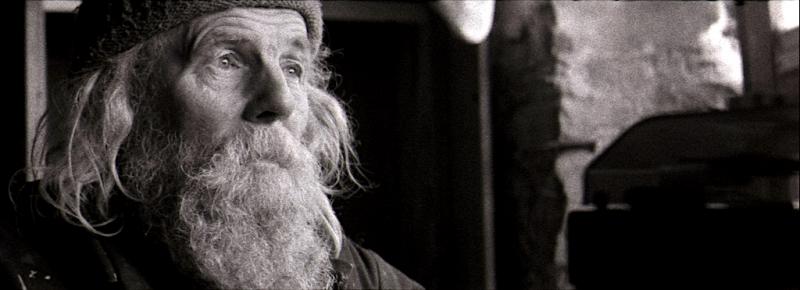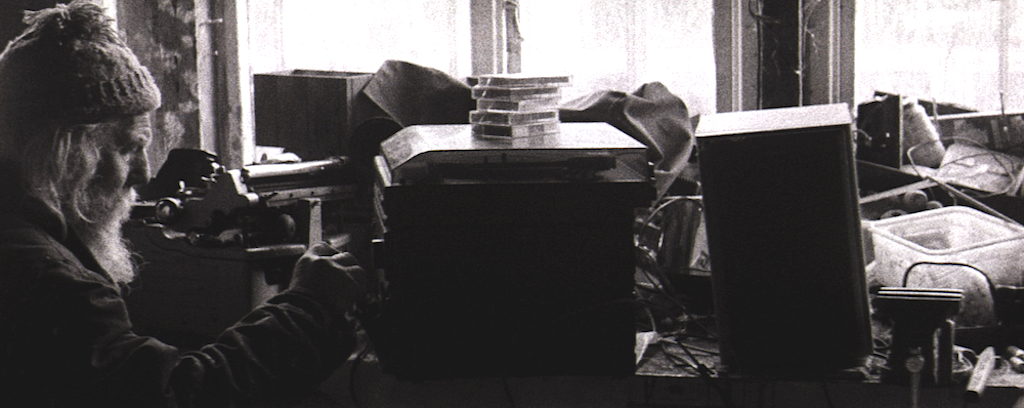Bogancloch review - every frame a work of art | reviews, news & interviews
Bogancloch review - every frame a work of art
Bogancloch review - every frame a work of art
Living off grid might be the meaning of happiness

Director Ben Rivers is primarily an artist, and it shows. Every frame of Bogancloch is treated as a work of art and the viewer is given ample time to relish the beauty of the framing, lighting and composition. Many of the shots fall into traditional categories such as still life, landscape and portraiture and would work equally well as photographs.
In fact, the whole film is structured as a series of episodes that are more like animated stills than narrative sequences. And it produces the sense of being in the continuous present – as in a painting or a photograph. It’s a perfect match for the world of Jake Williams, who lives off grid on the edge of a pine forest near the Cairngorms in Aberdeenshire. With no apparent responsibilities beyond his own survival, his life follows the organic rhythms of night and day, and Bogancloch conveys a feeling of time as a fluid entity rather than something divided into segments by the clock.
The use of black and white, 16 mm film also lends everything a timeless quality, partly by harking back to the early days of the medium and also by creating the impression that Williams’ solitary lifestyle is a throwback. Occasionally, though, this monochrome world is punctuated by a colour photograph. Without warning, the screen is filled by a water-damaged snapshot of Williams as a young man, of a road somewhere near Dubai or boats cruising down a river – as though memories of days spent far away from this retreat are prone to surface, unbidden. It makes one wonder why, 40 years ago, Williams chose to withdraw to this remote spot. He lives in a house with a long barn and very large greenhouse, both of which are surplus to requirements. Mountains of clobber litter the premises indoors and out – from dysfunctional vehicles, old car tyres and rotting filing cabinets to crumbling books, ancient typewriters and defunct telephones. Covered in dust or enmeshed in cobwebs, they are incredibly photogenic and, in lingering shots, Rivers invites us to savour their sepulchral beauty.
It makes one wonder why, 40 years ago, Williams chose to withdraw to this remote spot. He lives in a house with a long barn and very large greenhouse, both of which are surplus to requirements. Mountains of clobber litter the premises indoors and out – from dysfunctional vehicles, old car tyres and rotting filing cabinets to crumbling books, ancient typewriters and defunct telephones. Covered in dust or enmeshed in cobwebs, they are incredibly photogenic and, in lingering shots, Rivers invites us to savour their sepulchral beauty.
Williams potters about planting seedlings, making tea or repairing the glazing bars of the greenhouse while Rivers films him through dirty windows, slatted blinds, a grid of metal bars or a curtain of raindrops – drawing attention to the act of looking as much as to what is visible through these grimy veils.
Bogancloch is the second film he’s made with Williams. More than a decade has passed since Two Years at Sea (2011) and, in the meantime, the old man’s hair and beard have gone grey, and he has lost several teeth, yet he seems to be more active. It may be because, this time, Rivers has adopted a more hands-on approach to directing so that, as well as watching the old man listen to music (main picture), drink coffee and fall asleep, we see him plucking and cooking a pheasant found by the roadside, stacking logs, skiing through the pine forest and, in a wonderfully surreal sequence, explaining the solar system to a class of teenagers.
His teaching aid is a battered golfing umbrella that trails a sun and moon cut from the lids of tin cans. The kids dutifully watch this idiosyncratic demo, but as soon as the school bell rings, they’re off, abandoning Williams mid-sentence – bewildered by their sudden exit. Whereas the soundtrack of Two Years at Sea consisted mainly of bird song, whistling and ambient sound, Bogancloch features a lot of music. After cranking up the generator, Williams plays some of the tapes he’s gathered over the years (pictured above); along with Arabic music, there’s traditional jazz and a reading of a Seamus Heaney poem. And occasionally he breaks into tuneless but cheerful renditions of old favourites like Irving Berlin’s “Blue Skies”, as he rests in the forest against a lichen encrusted rock, and “Singing in the Bathtub” (from the 1924 Warner Brothers movie The Show of Shows) as he soaks blissfully in an outdoor bath (pictured above).
Whereas the soundtrack of Two Years at Sea consisted mainly of bird song, whistling and ambient sound, Bogancloch features a lot of music. After cranking up the generator, Williams plays some of the tapes he’s gathered over the years (pictured above); along with Arabic music, there’s traditional jazz and a reading of a Seamus Heaney poem. And occasionally he breaks into tuneless but cheerful renditions of old favourites like Irving Berlin’s “Blue Skies”, as he rests in the forest against a lichen encrusted rock, and “Singing in the Bathtub” (from the 1924 Warner Brothers movie The Show of Shows) as he soaks blissfully in an outdoor bath (pictured above).
The musical highlight is a visit from a choir who sing in exquisite harmony “The Flyting o’ Life and Death”, a song arranged by Alasdair Roberts in which, in alternate verses, life and death each lay claim to the world. Set round a camp fire after dark, this magical scene was obviously devised by Rivers. He shot the film in five visits over the course of a year, each time bringing new ideas for set pieces. It’s impossible to know, then, whether Bogancloch is a true reflection of William’s life. (Don’t even hope for answers to material questions such as what the old man eats or how he comes by necessities such as food, fuel and finance.)
But as a visual poem that invites you to question what makes for a meaningful life, Bogancloch is an absolute joy. And the final scene (which I won’t divulge) is a jaw-dropping delight. “This was always my ending,” says Rivers. “I dreamed about it.” He plans to make another sequel in 10 years time and hints that it will be in colour, which will make Williams’ environment seem less bleak and the conditions more benign. It will also add a new dimension to the beauty of the material.
rating
Share this article
The future of Arts Journalism
You can stop theartsdesk.com closing!
We urgently need financing to survive. Our fundraising drive has thus far raised £49,000 but we need to reach £100,000 or we will be forced to close. Please contribute here: https://gofund.me/c3f6033d
And if you can forward this information to anyone who might assist, we’d be grateful.

Subscribe to theartsdesk.com
Thank you for continuing to read our work on theartsdesk.com. For unlimited access to every article in its entirety, including our archive of more than 15,000 pieces, we're asking for £5 per month or £40 per year. We feel it's a very good deal, and hope you do too.
To take a subscription now simply click here.
And if you're looking for that extra gift for a friend or family member, why not treat them to a theartsdesk.com gift subscription?

Add comment